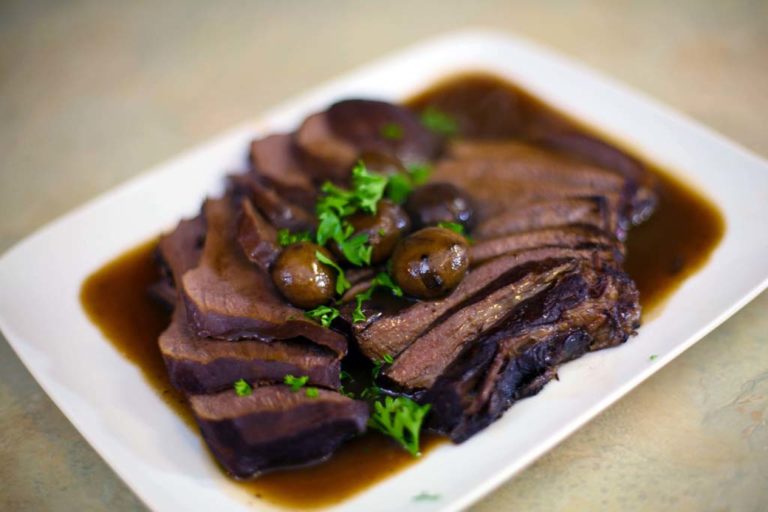
Chef's notes:
The beef tongue is an often-passed-over cut of meat . . . not that it has always been that way. A generation or two ago, we were more in touch with farming and animal husbandry, and eating beef tongue was just another special meal that happened once in a while, like chicken dinner after church on Sunday. But these days you will actually be hard-pressed to find beef tongue or even its younger, more tender version—veal tongue. But if you ask around, you might find a butcher who can get it for you. Ask real nice and in advance, and you may discover the little-known tenderness and deliciousness that is beef tongue.
If you have a Mexican Mercado, mercado is Spanish for market, in your town that is a good place to find beef tongue.
Ingredients
- 1 beef tongue
- ¼ pound bacon, small dice
- 3 shallots, quartered
- 2 cloves garlic, smashed
- 3 bay leaves
- 6 sprigs thyme, stripped
- 2‒4 cups dark chicken stock
- 2 cups Port or Madeira wine
- Salt
- Pepper
Braised Beef Tongue: Blanched, Peeled, and Braised in Madeira Wine, Chicken Stock and Herbs
- Buy a beef tongue to braise. As I stated above, it may in fact be hard for you to track a beef tongue down. But one thing that will help is having a butcher in town who actually cuts up their own meat. That increases the likelihood that they may have a beef tongue or at least may be able to get their hands on one. Otherwise you can always check the Internet.
- Blanch the beef tongue in water. Blanch the beef tongue by submerging it in cool water in a pot. Bring the beef tongue and water to a simmer but not a rolling boil. Keep your eye on the pot and add water if needed. Simmer the beef tongue for 1½‒2 hours. This part is kinda stinky, but once you get the tongue peeled the smell will go away.
- Peel the blanched beef tongue. Remove the tongue from the pot and let it cool a little before attempting to remove the skin. If the skin isn’t coming off very easily, use a fillet knife to slice it off. Be careful not to remove too much meat. Running it under cool water may help to remove the skin. Throw the skin in the trash; don’t try to put it down the garbage disposal.
- Begin making the braising liquid. Begin by frying the bacon over medium-high heat in the braising pan. Then once it starts to get brown, add the quartered shallots, garlic, bay leaves, and thyme. Fry them all together for a couple of minutes before adding the stock and wine. Start with 2 cups of each and add more stock if you need more liquid.
- Finish the braising liquid and put the beef tongue in the pan. I cut the beef tongue up to make it easier to braise, but you can braise the beef tongue whole if you want. The liquid in the pan should go just over halfway up the sides of the beef tongue. Add more stock if you need more liquid, but just stick with the original 2 cups of wine.
- Braise the beef tongue in the oven at 350 degrees F for 3‒4 hours. To get a really good seal I cover my braising pan with aluminum foil. It also makes it easier to clean the inside of the lid, which can get very dirty. Every hour, take the braising pan out of the oven and flip the beef tongue over. Add more stock if needed.
- Remove the braised beef tongue and let it rest. When the beef tongue has finished braising for 3‒4 hours, it will be soft to the touch but not falling apart. Let the beef tongue rest for 30 minutes before slicing and serving it. Serve it with the braising liquid. To perfect the liquid, remove the fat floating on the surface and adjust the flavors; then boil it down or thicken it with cornstarch or gelatin.
Tips & Tricks
- Raw, unblanched and unpeeled beef tongue has a sort of cow smell to it, so smelling it for freshness is sort of out.
- Buy frozen if you have to. It may actually work out better.
- You can use veal tongues instead for this beef tongue recipe. Just don’t braise them as long, maybe 2 hours.
- Instead of shallots you can use an onion.
- The slow and low method works really well for beef tongue because it is a very dense muscle and needs to be softened. It’s dense but delicate. Perhaps supple is the correct word.
- Beef tongue can be cut across the grain or with it; as long as you braised the meat for 3‒4 hours, it will be good to go.
- I like to cut beef tongue horizontally into large slabs. They make really great sandwiches.
- You can always put the braised beef tongue in the fridge overnight to make removing the grease easier. Just scoop the grease off in the morning and then reheat the tongue in the juices and serve.
